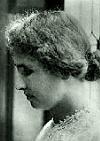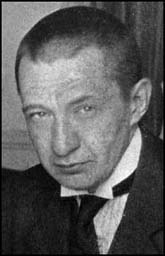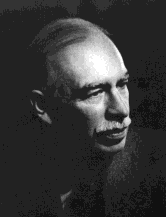Ke
Keller, Helen (1880-1968)
 Deaf-blind American author, socialist and speaker.
Deaf-blind American author, socialist and speaker.
Born in Alabama, a fever when she was 19 months old caused her to lose sight and hearing. In 1886, her mother took her to Baltimore where she met Alexander Graham Bell, who was working with deaf children at the time. Via the Perkins Institute for the Blind, she met Anne Sullivan, herself partially visually impaired and then only 20 years old, who worked with Helen for the next 50 years, teaching her to think and speak effectively, touching the lips of others as they spoke, feeling the vibrations, and spelling of alphabetical characters in the palm of Helen’s hand. Helen learned to read English, French, German, Greek, and Latin in braille.
Helen went on to become a world-famous speaker and author. In 1915 she founded Helen Keller International, a non-profit organization for preventing blindness. She actively campaigned and wrote in support of the working classes from 1909 to 1921, supporting Socialist Party candidate Eugene V. Debs in each of his campaigns for the presidency. She visited sweatshops, factories, crowded slums to meet workers. Helen Keller also joined the IWW in 1912 after she felt that parliamentary socialism was “sinking in the political bog,” and wrote for the IWW between 1916 and 1918. In “Why I Became an IWW” Helen wrote that her motivation for activism came in part due to her concern about blindness and other disabilities. In 1920 she was one of the founders of the American Civil Liberties Union.
See Helen Keller Archive.
Keracher, John (1880-1958)
Scottish-born, organizer, public speaker, educator and pamphleteer, a founding member of the Communist Party of the U.S., and for many years the central figure of the Proletarian Party.
Keracher emigrated to the United States in 1909 and settled in Detroit, where he ran a shoe store, and in April 1910 he joined the Socialist Party.
Discouraged by what he regarded as the low theoretical level of the Socialist Party, he launched a state-wide party education program based on study of the classics of Marxism. This program culminated in the “Proletarian University of Detroit,” within which Keracher was the most notable and popular teacher. It was here that Keracher came in contact with the Socialist publisher Charles H. Kerr.
Through this work, Keracher became the leader of the Socialist Party in Michigan, while Michigan became the fastest-growing and most radical state organisation of the Party, frequently at odds with the more conservative national leadership.
In August 1918, a group around Keracher launched The Proletarian (later, Proletarian News), adopting the principles of the Socialist Party of Great Britain (SPGB). However, the group became more aligned with the Bolsheviks and was expelled from the Socialist Party of America (SPA) in May, 1919. The ostensible reason for the expulsion was the Michigan section’s vehement antireligious stance which was contrary to the Party’s statutes.
A few weeks later, in September 1919, Keracher participated in the founding of the Communist Party in Chicago. However, unlike most of those who were joining the Communist Party at this time, Keracher did not believe in an imminent Bolshevik Revolution in the United States. He opposed the Communist Party’s “underground” work and opposed the formation of Left unions.
In January 1920, Keracher’s Michigan group (including those associated with the group who lived outside that state) was expelled from the Communist Party charged with “Menshevism.” Whilst Keracher continued to support Bolshevism, he denied that socialism had been established in Russia. Six months later, in June 1920, the Michigan group formed the Proletarian Party, and Keracher remained the leader of the Proletarian Party for the rest of his life.
John Keracher was the author of countless easy-to-read basic pamphlets, mainly on Marxist economics, as well as articles and editorials in Proletarian News. As the Proletarian Party grew, local branches emerged in at least 38 U.S. cities. Although there were branches on both coasts, its stronghold was still the industrial Midwest.
The party achieved considerable impact through its emphasis on worker education, despite its relatively small size. Many of the party’s members graduated to become prominent labor leaders, especially in the Congress of Industrial Organizations (CIO). The party is credited by some with inciting the 1937 Flint sit-down strike.
Keracher was a gifted street speaker and indefatiguable lecturer, and his popularisations of Marxism were used, not only by his own Party, but by other socialist groups, the IWW and Free Thinking societies.
Charles H. Kerr, wishing to retire, sold Keracher the controlling interest in his publishing house, and Keracher and his comrades mnanaged the firm, continuing its tradition as a broad, socialist press though very hard times.
Keracher moved from Detroit to Chicago in the 1920s, moving to Los Angeles in the 1950s, where he died in 1958. The Proletarian Party finally disappeared in 1971.
Kerensky, Alexander (1882-1970)
 Member of the right wing of the Socialist Revolutionary Party. At the time of the February Revolution, Kerensky was vice-chairman of the Petrograd Soviet. He became Minister of Justice in the newly formed government; but by the tumtulous July events he accepted the seat of prime minister of the Provisional Government. when it was overthrown in October, 1917. Went into exile in the United States and worked as a professor.
Member of the right wing of the Socialist Revolutionary Party. At the time of the February Revolution, Kerensky was vice-chairman of the Petrograd Soviet. He became Minister of Justice in the newly formed government; but by the tumtulous July events he accepted the seat of prime minister of the Provisional Government. when it was overthrown in October, 1917. Went into exile in the United States and worked as a professor.
See Alexander Kerensky Archive.
Kerzhentsev, Platen M. (1881-1940)
Bolshevik since 1904, he was appointed to several literary and cultural posts in the Soviet government, including a prominent post in Soviet radio and in the fine arts. President of the Rabkrin Council for the Scientific Organization of Labor from 1923 to 1924. Editor of Vremya, the journal of a "League of Time," an organization to promote the rationalization of work by measurements in terms of time occupied.
Key, Ellen (1849 - 1926)
Swedish proletarian revolutionary and woman of letters who wrote on women’s questions and child education.
Keynes, John Neville (1852-1949)
British philosopher and economist who synthesised the two poles of British economic thought, using both inductive and deductive reasoning in his methodology.
Keynes was educated at the universities of London and Cambridge. After graduating from Cambridge (1875), he was a lecturer in moral science there (1884-1911) and then served as registrar of the university (1910-25). He was active in the foundation of the Economics Tripos at Cambridge.
Keynes’s most important contributions to economics were as a logician and methodologist. His two chief works are Studies and Exercises in Formal Logic (1884), which was popular for its clarity of expression and avoidance of mathematical symbolism, and his classic work on economic methodology, The Scope and Method of Political Economy (1891). This work categorised the various approaches to economics as inductive and deductive, with Keynes adopting a syncretistic position. At a time when the German-speaking world was engaged in the Methodenstreit ("battle of methods") between the Austrian economic school led by Carl Menger, which advocated a deductive approach and stressed the importance of pure theory, and the followers of German economist Gustav Schmoller, who insisted on the importance of inductive studies, Keynes, by contrast, insisted that both induction and deduction were required. He felt that inductive reasoning provided the general premises upon which deduction had to be based and that deduction resulted in generalisations or laws which then had to be tested by inductive procedures.
Keynes was the father of the most influential economist of the 20th century, John Maynard Keynes.
Keynes, John Maynard (1883-1946)
 English economist, journalist, and financier, best known for his "Keynesian economics" and theories on the causes of prolonged unemployment. His most important work, The General Theory of Employment, Interest and Money (1935-36), advocated a remedy for economic recession based on a government-sponsored policy of full employment.
English economist, journalist, and financier, best known for his "Keynesian economics" and theories on the causes of prolonged unemployment. His most important work, The General Theory of Employment, Interest and Money (1935-36), advocated a remedy for economic recession based on a government-sponsored policy of full employment.
Keynes was born into a moderately prosperous family of the professional elite. His father was an esteemed economic scholar and later academic administrator at the University of Cambridge. His mother, the daughter of a minister endowed with advanced opinions, was one of the first female graduates of the same university.
An obviously gifted youngster, though he had a somewhat delicate constitution, he excelled both as a mathematician and as a scholar of the classics and showed a talent for the management of student societies. His undergraduate essay on The Political Philosophy of Edmund Burke showed an early interest in political philosophy.
At King’s College, Cambridge, he blossomed as a polemical speaker, becoming president of the University Union Society. Gradually, as he came under the influence of Alfred Marshall, the leading Cambridge economist, his mathematical interests diminished, and his attachment to politics and economics increased.
Cambridge introduced Keynes to an important circle of writers and artists. The early history of Bloomsbury, that exclusive circle of the cultural elect, which counted among its members Leonard and Virginia Woolf, the painter Duncan Grant, and the art critic Clive Bell, centres upon Cambridge and the figure of Lytton Strachey.
After graduating from Cambridge, Keynes became a civil servant and moved to the India Office in Whitehall. His experience there formed the basis of his first major work, which is still the definitive examination of pre-World War I Indian finance and currency. He then returned to Cambridge, where he taught economics with great success until 1915. The onset of World War I brought him back to government employment, where he was daily concerned with the economic management of the war.
Accompanying Lloyd George to the Versailles Peace Conference as an economic adviser, Keynes soon became so distressed at the political chicaneries of the proceedings and the unrealistic character of the reparations policies to be imposed upon a defeated Germany that his health deteriorated, and he resigned his post.
He composed the indictment of the Versailles settlement that by Christmas 1919 reached the bookstores as The Economic Consequences of the Peace. The permanent importance of this polemical essay lies in its economic analysis of the excessive weight of reparations upon the German economy and the improbability that they ever would be paid.
In Cambridge, to which Keynes now returned, he was esteemed as the most brilliant student of Alfred Marshall and A.C. Pigou, the two eminent Cambridge economists. Although the tone of Keynes’s major writings in the 1920s was occasionally sceptical, he did not directly challenge the conventional wisdom of the period that held laissez-faire.
Keynes’ Treatise on Probability, published in 1920, was described by Bertrand Russell as "the most important work on probability for 55 years", and shows that if a hypothesis has even the smallest finite probability, then it can be transformed into cerainty by sufficiently many observations. In this way he sought to overcome Humean scepticism by the assertion that theoretcially grounded hypotheses need only be shown to have finite probability to form the basis of science and rational action.
Keynes’ epistemology began from the British idealist utilitarian G. E. Moore, "in which universals originate and exist only in the mind; and although a concept may be chosen by reason and art to describe a collection of imperfectly similar units, nevertheless, that concept cannot be assumed to exist in real life. ...Platonic metaphysics was ... manifested in the Treatise as the doctrine of rational intuition, ... our state of knowledge of practical affairs is not sufficient, except in trivial instances, ... but we can anticipate the future by seeing, in an artistic but rational way, that there is a pattern to the facts. ... Nevertheless, his world of elusive change is not consistent with utilitarianism, and Keynes criticised that doctrine repeatedly and without a word of qualification. Not only did the Treatise deny that there is any generally predictable connection between an action and its outcome, but even where the consequences were known, Keynes’ ethics advocated ’being good’ rather than ’doing good’ ... Keynes referred to this doctrine as a logic of motives rather than of consequences." [from The significance of Keynes’ Idealism, Athol Fitzgibbons]
In 1925 he opposed England’s return to the gold standard at the pre-war dollar-pound ratio of $4.86; and, long before the Great Depression, supported the Liberal Party’s program of public works to take the unemployed off welfare. But respectable economists still relied upon the expected automatic adjustments of the free market. Since Keynes could not yet offer a theoretical refutation of his colleagues’ opinions, his agitation for public works had little political effect.
As a journalist he extended his reputation, writing in the New Statesman, The Times and the Manchester Guardian.
In the United States Franklin Roosevelt’s 1932 landslide presidential victory over Herbert Hoover attested to the political bankruptcy of laissez-faire as an antedote to the Great Depression. Keynes’ enduring triumph was his composition in the early 1930s of the most influential treatise composed by an economist thus far in this century, comparable to Adam Smith’s Wealth of Nations and Malthus’ Essay on Population. The General Theory of Employment, Interest and Money, which appeared in 1935-36, is a highly technical, even abstruse exposition of new ideas that had been partly foreshadowed in his Treatise on Money (1930).The central message is that in a depression, there was no wage so low that it could eliminate unemployment. Accordingly, it was wicked to blame the unemployed for their plight and explained the origins of unemployment and depression by aggregate demand - i.e., the total spending of consumers, business investors, and public agencies. When aggregate demand was low, sales and jobs suffered. When it was high, all was well.
From these generalities there flowed a powerful and comprehensive view of economic behaviour. Because consumers were limited in their spending by the size of their incomes, they were not the source of business cycle fluctuations. The dynamic actors were business investors and governments. In depressions the thing to do was either to enlarge private investment or to create public substitutes for private investment deficiencies. In mild economic contractions, monetary policy in the shape of easier credit and lower interest rates just might stimulate business investment and restore the aggregate demand caused by full employment. Severer contractions required as therapy the sterner remedy of deliberate public deficits either in the shape of public works or subsidies to afflicted groups.
During World War II and after, one Western country after another affirmed its new commitment to maintain high employment.
The General Theory was Keynes’s last major written work. In 1937 he suffered a severe heart attack. Two years later, though not completely recovered, he returned to teaching at Cambridge, wrote three influential articles on war finance entitled How to Pay for the War, and served once more in the Treasury as an all-purpose adviser. As the war drew to a victorious conclusion, Keynes turned his thoughts to the design of international financial institutions calculated to limit the spread of depression. At the Bretton Woods Conference in 1944 he played a prominent part. But the institutions that resulted from the conference, the International Monetary Fund and the World Bank - two agencies that survive into the 1980s - bear much stronger marks of the orthodox theories of the United States Treasury of that time than of Keynes’s thinking.
His last major public service was his brilliant negotiation in the autumn and early winter of 1945 of a multibillion-dollar loan granted by the United States to England. He was now both a member of the Court of the Bank of England and, as Lord Keynes of Tilton, a peer of the realm. Keynes died in 1946.
See J M Keynes Archive and The Crisis of Keynesian Economics, A Marxist View (Geoff Pilling, 1986).